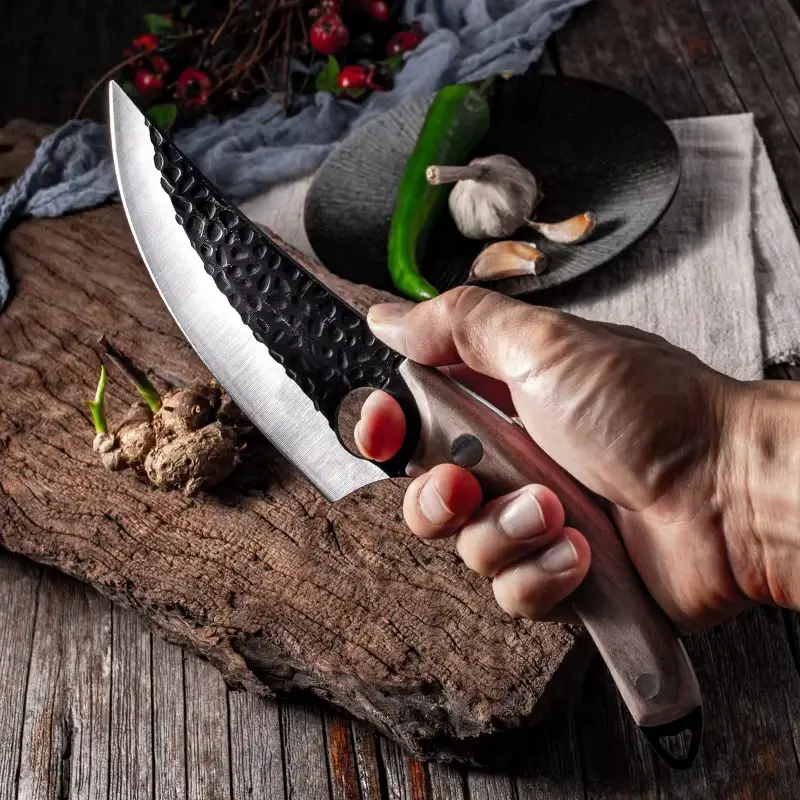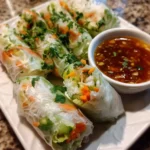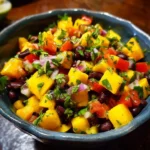Coconut Crusted Tilapia with Rice has become a weeknight staple in our home, and for good reason. It’s a dish that manages to be both incredibly flavorful and surprisingly healthy, a combination that’s always a winner in my book. Even my picky eaters, who often turn their noses up at fish, are completely on board with this recipe. The crispy, sweet coconut crust on the tender tilapia is just irresistible, and paired with fluffy rice, it creates a balanced and satisfying meal that’s ready in under an hour. Honestly, from the first bite, you’re transported to a tropical paradise, right in your own kitchen. It’s the kind of dish that feels special enough for a weekend dinner party, yet simple enough for a busy weeknight. If you’re looking for a way to add some excitement to your fish routine, or just want a delicious, crowd-pleasing meal, you absolutely have to try this Coconut Crusted Tilapia with Rice.
Ingredients for Coconut Crusted Tilapia
- Tilapia Fillets: The star of the show, choose firm, white tilapia fillets, about 1-1.5 pounds for four servings.
- Unsweetened Shredded Coconut: Provides the signature tropical flavor and crispy texture for the crust.
- Panko Breadcrumbs: Adds extra crispiness and structure to the coconut crust.
- All-Purpose Flour: Helps the egg wash adhere to the tilapia and the crust to stick.
- Eggs: Acts as a binder, helping the coconut and breadcrumbs adhere to the tilapia fillets.
- Lime Juice: Brightens the flavor of the tilapia and complements the coconut.
- Spices (Salt, Black Pepper, Garlic Powder, Paprika): Enhances the flavor profile of the tilapia and the crust.
- Vegetable Oil or Coconut Oil: For pan-frying the tilapia to golden perfection.
Ingredients for Fluffy Rice
- Long-Grain Rice: Provides a light and fluffy base to complement the tilapia.
- Water or Chicken Broth (Vegetable Broth for Vegetarian Option): Liquid for cooking the rice, broth adds extra flavor.
- Salt: To season the rice and enhance its taste.
- Butter or Olive Oil (Optional): Adds richness and flavor to the cooked rice.
Instructions
Preparation of the Tilapia:
- Pat Dry and Season: Begin by gently patting the tilapia fillets dry with paper towels. This step is crucial for achieving a crispy crust as it removes excess moisture. Season both sides of the tilapia fillets generously with salt, black pepper, garlic powder, and paprika. Ensure even distribution of the spices for maximum flavor in every bite.
- Lime Juice Marinade: Squeeze fresh lime juice over both sides of the seasoned tilapia fillets. The lime juice not only adds a zesty brightness that cuts through the richness of the coconut but also helps to tenderize the fish and eliminate any potential fishy odors. Let the tilapia marinate in the lime juice for about 10-15 minutes. This short marinade time is enough to infuse the fish with flavor without making it mushy.
- Prepare the Breading Station: Set up a breading station with three shallow dishes. In the first dish, place the all-purpose flour. In the second dish, whisk the eggs lightly to create an egg wash. In the third dish, combine the unsweetened shredded coconut and panko breadcrumbs. Mix these together thoroughly to ensure an even distribution of coconut and breadcrumbs for a uniformly crispy crust.
Creating the Coconut Crust:
- Flour Coating: Dredge each tilapia fillet in the all-purpose flour, ensuring that both sides are evenly coated. Shake off any excess flour. The flour acts as a base for the egg wash and helps the crust adhere better to the fish.
- Egg Wash: Dip the flour-coated tilapia fillet into the whisked egg wash, making sure it’s fully submerged and coated. Allow any excess egg wash to drip off. The egg wash is the “glue” that will bind the coconut-breadcrumb mixture to the tilapia.
- Coconut-Breadcrumb Coating: Immediately transfer the egg-washed tilapia fillet to the dish with the coconut and panko breadcrumb mixture. Press the mixture firmly onto both sides of the fillet, ensuring a thick and even coating. This step is key to achieving that signature crispy coconut crust. Repeat this breading process for all the tilapia fillets.
Cooking the Coconut Crusted Tilapia:
- Heat the Oil: In a large skillet, preferably non-stick, heat vegetable oil or coconut oil over medium-high heat. Use enough oil to shallow fry the tilapia, about ¼ to ½ inch deep. The oil should be hot enough so that when you place a piece of breadcrumb in it, it sizzles immediately but doesn’t burn quickly.
- Pan-Fry the Tilapia: Carefully place the coconut-crusted tilapia fillets into the hot oil, ensuring not to overcrowd the pan. Overcrowding can lower the oil temperature and result in steaming rather than frying, which will make the crust soggy instead of crispy. Cook the tilapia for about 3-4 minutes per side, or until the crust is golden brown and crispy, and the fish is cooked through and flakes easily with a fork. The cooking time will vary depending on the thickness of the fillets.
- Drain Excess Oil: Once cooked, remove the tilapia fillets from the skillet and place them on a wire rack lined with paper towels to drain any excess oil. This step helps maintain the crispiness of the crust.
Preparing the Rice:
- Rinse the Rice (Optional but Recommended): Rinsing the long-grain rice under cold water until the water runs clear helps remove excess starch, resulting in fluffier rice. This step is optional but recommended for optimal texture.
- Combine Rice and Liquid: In a medium saucepan, combine the rinsed rice (or unrinsed rice if you skipped rinsing), water or broth, and salt. The standard ratio is usually 2 cups of liquid for every 1 cup of rice, but check the package instructions for your specific rice brand. Using broth instead of water will infuse the rice with extra flavor.
- Bring to a Boil, then Simmer: Bring the mixture to a rolling boil over high heat. Once boiling, reduce the heat to low, cover the saucepan tightly with a lid, and simmer for 15-20 minutes, or according to the package instructions, until all the liquid is absorbed and the rice is tender. Avoid lifting the lid during the simmering process as this releases steam and can affect the cooking of the rice.
- Rest and Fluff: Once the rice is cooked, remove the saucepan from the heat and let it stand, covered, for 5-10 minutes. This resting period allows the steam to redistribute, resulting in even fluffier rice. After resting, fluff the rice gently with a fork to separate the grains.
- Enhance the Rice (Optional): For extra flavor and richness, stir in a pat of butter or a drizzle of olive oil into the cooked rice after fluffing. This is optional but adds a lovely touch.
Serving:
- Plate and Serve: Place a generous serving of fluffy rice on each plate and top with a piece of crispy coconut crusted tilapia. Serve immediately while the tilapia is hot and the crust is at its crispiest. Garnish with fresh lime wedges and chopped cilantro or parsley for a pop of freshness and color.
Nutrition Facts (per serving, approximate)
- Serving Size: 1 Tilapia Fillet with ¾ cup Rice
- Calories: Approximately 450-550 kcal
- Protein: 30-35g
(Note: Nutritional values are estimates and can vary based on specific ingredients, portion sizes, and cooking methods. For precise values, use a nutrition calculator with specific ingredient brands and quantities.)
Preparation Time
- Prep Time: 20 minutes (includes marinating and breading)
- Cook Time: 25 minutes (includes frying tilapia and cooking rice)
- Total Time: 45 minutes (Quick and easy for a weeknight meal!)
How to Serve Coconut Crusted Tilapia with Rice
This Coconut Crusted Tilapia with Rice is delicious on its own, but it truly shines when paired with complementary side dishes and garnishes. Here are some serving suggestions to elevate your meal:
- Classic Sides:
- Steamed or Roasted Vegetables: Broccoli, asparagus, green beans, or bell peppers are excellent choices. Their fresh, slightly bitter flavors balance the richness of the coconut crust. Roasting vegetables brings out their natural sweetness.
- Side Salad with a Light Vinaigrette: A refreshing salad with mixed greens, tomatoes, cucumbers, and a lemon or lime vinaigrette provides a crisp contrast to the warm, crispy tilapia and rice.
- Coleslaw: A creamy or vinegar-based coleslaw adds a cool and crunchy element that complements the tropical flavors of the dish.
- Tropical Inspired Pairings:
- Mango Salsa: The sweetness of mango salsa with a hint of spice from jalapeño and freshness from cilantro is a perfect tropical accompaniment.
- Pineapple Salsa: Similar to mango salsa, pineapple salsa offers a tangy and sweet counterpoint to the savory tilapia.
- Avocado Crema: A creamy avocado crema, made with avocado, lime juice, cilantro, and a touch of sour cream or Greek yogurt, adds richness and coolness.
- Black Beans and Corn Salad: A vibrant salad with black beans, corn, red onion, bell peppers, and a lime dressing brings a Southwestern-tropical fusion to the meal.
- Garnishes and Toppings:
- Lime Wedges: Essential for squeezing over the tilapia and rice, adding a final burst of acidity and freshness.
- Fresh Cilantro or Parsley: Chopped fresh herbs sprinkled over the dish enhance the aroma and visual appeal.
- Toasted Coconut Flakes: For extra coconut flavor and visual texture, sprinkle some toasted coconut flakes over the plated dish.
- Sriracha Mayo or Spicy Aioli: If you like a bit of heat, a drizzle of sriracha mayo or spicy aioli adds a creamy and spicy kick.
- Serving Style:
- Family Style: Serve the tilapia and rice in large serving dishes in the center of the table, allowing everyone to help themselves and create their own plates.
- Plated Meals: Create individual plates with a portion of rice, a tilapia fillet, and chosen side dishes for a more formal presentation.
Additional Tips for Perfect Coconut Crusted Tilapia
To ensure your Coconut Crusted Tilapia is a resounding success every time, here are eight helpful tips to keep in mind:
- Use Fresh, Good Quality Tilapia: Start with the freshest tilapia fillets you can find. Fresh fish will have a better flavor and texture. Look for fillets that are firm, moist, and have a mild, clean smell. Avoid fishy-smelling tilapia, as this is an indication of age or poor quality.
- Don’t Skip Patting Dry: Thoroughly patting the tilapia fillets dry with paper towels before seasoning and breading is crucial. Excess moisture will prevent the flour, egg wash, and coconut crust from adhering properly, resulting in a soggy crust instead of a crispy one.
- Toast the Coconut Flakes (Optional but Recommended): Toasting the shredded coconut flakes before using them in the crust enhances their flavor and adds a deeper, nuttier note to the dish. To toast coconut, spread it in a dry skillet over medium heat and cook, stirring frequently, until lightly golden brown and fragrant. Be careful not to burn it, as it can toast quickly.
- Ensure Oil is Hot Enough: The oil should be adequately heated before adding the tilapia. If the oil isn’t hot enough, the crust will absorb too much oil and become greasy instead of crispy. Test the oil temperature by dropping a few breadcrumbs into it; they should sizzle immediately and turn golden brown within seconds. Use a thermometer for precise temperature control if you have one; aim for around 350°F (175°C).
- Avoid Overcrowding the Pan: Fry the tilapia fillets in batches, ensuring not to overcrowd the skillet. Overcrowding lowers the oil temperature, which leads to steaming instead of frying and results in a soggy crust. Cook in smaller batches to maintain the oil temperature and achieve optimal crispiness.
- Don’t Overcook the Tilapia: Tilapia is a delicate fish that cooks quickly. Overcooking will make it dry and rubbery. Cook just until the fish is cooked through and flakes easily with a fork. The internal temperature should reach 145°F (63°C). The crust should be golden brown and crispy, and the fish should be opaque and moist inside.
- Use Panko Breadcrumbs for Extra Crispiness: Panko breadcrumbs are Japanese-style breadcrumbs that are larger and flakier than regular breadcrumbs. They provide a lighter and crispier texture to the crust compared to regular breadcrumbs. Using a combination of panko and shredded coconut creates the perfect balance of flavor and texture.
- Serve Immediately for Best Crispiness: Coconut Crusted Tilapia is best enjoyed immediately after cooking while the crust is at its peak crispiness. The longer it sits, the softer the crust will become due to moisture. If you need to keep it warm briefly, place it on a wire rack in a low oven (around 200°F or 95°C), but for the best texture, serve it fresh off the skillet.
Frequently Asked Questions (FAQ) about Coconut Crusted Tilapia
Q1: Can I use frozen tilapia fillets for this recipe?
A: Yes, you can use frozen tilapia fillets. Make sure to thaw them completely before starting the recipe. Pat them dry thoroughly after thawing to remove excess moisture, which is especially important for achieving a crispy crust. Thawing overnight in the refrigerator is the safest and best method.
Q2: Can I bake the tilapia instead of pan-frying to make it healthier?
A: Yes, you can bake the coconut crusted tilapia. Preheat your oven to 400°F (200°C). Place the breaded tilapia fillets on a baking sheet lined with parchment paper. Drizzle or spray lightly with oil. Bake for 15-20 minutes, or until the fish is cooked through and the crust is golden brown. Baking will be healthier as it uses less oil, but the crust may not be as uniformly crispy as pan-frying.
Q3: What can I use instead of panko breadcrumbs if I don’t have them?
A: If you don’t have panko breadcrumbs, you can substitute them with regular breadcrumbs, crushed cornflakes, or even crushed crackers. However, panko breadcrumbs provide the best crispy texture. If using regular breadcrumbs, you might want to toast them lightly in a dry pan before mixing with the coconut for added crispness.
Q4: Can I make this recipe gluten-free?
A: Yes, to make this recipe gluten-free, you can use gluten-free all-purpose flour and gluten-free panko breadcrumbs. Ensure all other ingredients, like spices and any broth used for rice, are also certified gluten-free if necessary for dietary restrictions.
Q5: Can I prepare the coconut crust ahead of time?
A: It’s best to prepare the coconut crust just before cooking. If you prepare it too far in advance, the breadcrumbs and coconut may absorb moisture and become less crispy. However, you can mix the coconut and panko breadcrumbs together and store them in an airtight container at room temperature until you’re ready to bread the tilapia.
Q6: How do I store leftover Coconut Crusted Tilapia?
A: Store leftover Coconut Crusted Tilapia in an airtight container in the refrigerator for up to 2-3 days. However, keep in mind that the crust will soften in the refrigerator. To reheat, you can bake it in the oven at 350°F (175°C) for about 10-15 minutes, or until heated through. Reheating in an air fryer can also help to crisp up the crust again. Microwaving is not recommended as it will make the crust soggy.
Q7: Can I use different spices in the coconut crust?
A: Absolutely! Feel free to customize the spices in the coconut crust to your liking. You can add a pinch of cayenne pepper for a bit of heat, curry powder for an Indian-inspired flavor, or Italian seasoning for a Mediterranean twist. Experiment with different spice combinations to find your favorite flavor profile.
Q8: What are some good side dishes to serve with Coconut Crusted Tilapia and Rice besides vegetables?
A: Besides vegetables, great side dishes include mango or pineapple salsa, a black bean and corn salad, coleslaw, avocado crema, or even a simple side of quinoa or couscous instead of rice for variety. Consider sides that offer a contrast in texture and flavor, such as something creamy, something crunchy, and something fresh and acidic.

Coconut Crusted Tilapia with Rice
Ingredients
-
Ingredients for Coconut Crusted Tilapia
- Tilapia Fillets: The star of the show, choose firm, white tilapia fillets, about 1-1.5 pounds for four servings.
- Unsweetened Shredded Coconut: Provides the signature tropical flavor and crispy texture for the crust.
- Panko Breadcrumbs: Adds extra crispiness and structure to the coconut crust.
- All-Purpose Flour: Helps the egg wash adhere to the tilapia and the crust to stick.
- Eggs: Acts as a binder, helping the coconut and breadcrumbs adhere to the tilapia fillets.
- Lime Juice: Brightens the flavor of the tilapia and complements the coconut.
- Spices (Salt, Black Pepper, Garlic Powder, Paprika): Enhances the flavor profile of the tilapia and the crust.
- Vegetable Oil or Coconut Oil: For pan-frying the tilapia to golden perfection.
Ingredients for Fluffy Rice
- Long-Grain Rice: Provides a light and fluffy base to complement the tilapia.
- Water or Chicken Broth (Vegetable Broth for Vegetarian Option): Liquid for cooking the rice, broth adds extra flavor.
- Salt: To season the rice and enhance its taste.
- Butter or Olive Oil (Optional): Adds richness and flavor to the cooked rice.
Instructions
-
Preparation of the Tilapia:
- Pat Dry and Season: Begin by gently patting the tilapia fillets dry with paper towels. This step is crucial for achieving a crispy crust as it removes excess moisture. Season both sides of the tilapia fillets generously with salt, black pepper, garlic powder, and paprika. Ensure even distribution of the spices for maximum flavor in every bite.
- Lime Juice Marinade: Squeeze fresh lime juice over both sides of the seasoned tilapia fillets. The lime juice not only adds a zesty brightness that cuts through the richness of the coconut but also helps to tenderize the fish and eliminate any potential fishy odors. Let the tilapia marinate in the lime juice for about 10-15 minutes. This short marinade time is enough to infuse the fish with flavor without making it mushy.
- Prepare the Breading Station: Set up a breading station with three shallow dishes. In the first dish, place the all-purpose flour. In the second dish, whisk the eggs lightly to create an egg wash. In the third dish, combine the unsweetened shredded coconut and panko breadcrumbs. Mix these together thoroughly to ensure an even distribution of coconut and breadcrumbs for a uniformly crispy crust.
Creating the Coconut Crust:
- Flour Coating: Dredge each tilapia fillet in the all-purpose flour, ensuring that both sides are evenly coated. Shake off any excess flour. The flour acts as a base for the egg wash and helps the crust adhere better to the fish.
- Egg Wash: Dip the flour-coated tilapia fillet into the whisked egg wash, making sure it’s fully submerged and coated. Allow any excess egg wash to drip off. The egg wash is the “glue” that will bind the coconut-breadcrumb mixture to the tilapia.
- Coconut-Breadcrumb Coating: Immediately transfer the egg-washed tilapia fillet to the dish with the coconut and panko breadcrumb mixture. Press the mixture firmly onto both sides of the fillet, ensuring a thick and even coating. This step is key to achieving that signature crispy coconut crust. Repeat this breading process for all the tilapia fillets.
Cooking the Coconut Crusted Tilapia:
- Heat the Oil: In a large skillet, preferably non-stick, heat vegetable oil or coconut oil over medium-high heat. Use enough oil to shallow fry the tilapia, about ¼ to ½ inch deep. The oil should be hot enough so that when you place a piece of breadcrumb in it, it sizzles immediately but doesn’t burn quickly.
- Pan-Fry the Tilapia: Carefully place the coconut-crusted tilapia fillets into the hot oil, ensuring not to overcrowd the pan. Overcrowding can lower the oil temperature and result in steaming rather than frying, which will make the crust soggy instead of crispy. Cook the tilapia for about 3-4 minutes per side, or until the crust is golden brown and crispy, and the fish is cooked through and flakes easily with a fork. The cooking time will vary depending on the thickness of the fillets.
- Drain Excess Oil: Once cooked, remove the tilapia fillets from the skillet and place them on a wire rack lined with paper towels to drain any excess oil. This step helps maintain the crispiness of the crust.
Preparing the Rice:
- Rinse the Rice (Optional but Recommended): Rinsing the long-grain rice under cold water until the water runs clear helps remove excess starch, resulting in fluffier rice. This step is optional but recommended for optimal texture.
- Combine Rice and Liquid: In a medium saucepan, combine the rinsed rice (or unrinsed rice if you skipped rinsing), water or broth, and salt. The standard ratio is usually 2 cups of liquid for every 1 cup of rice, but check the package instructions for your specific rice brand. Using broth instead of water will infuse the rice with extra flavor.
- Bring to a Boil, then Simmer: Bring the mixture to a rolling boil over high heat. Once boiling, reduce the heat to low, cover the saucepan tightly with a lid, and simmer for 15-20 minutes, or according to the package instructions, until all the liquid is absorbed and the rice is tender. Avoid lifting the lid during the simmering process as this releases steam and can affect the cooking of the rice.
- Rest and Fluff: Once the rice is cooked, remove the saucepan from the heat and let it stand, covered, for 5-10 minutes. This resting period allows the steam to redistribute, resulting in even fluffier rice. After resting, fluff the rice gently with a fork to separate the grains.
- Enhance the Rice (Optional): For extra flavor and richness, stir in a pat of butter or a drizzle of olive oil into the cooked rice after fluffing. This is optional but adds a lovely touch.
Serving:
- Plate and Serve: Place a generous serving of fluffy rice on each plate and top with a piece of crispy coconut crusted tilapia. Serve immediately while the tilapia is hot and the crust is at its crispiest. Garnish with fresh lime wedges and chopped cilantro or parsley for a pop of freshness and color.
Nutrition
- Serving Size: one normal portion
- Calories: 550
- Protein: 35g






